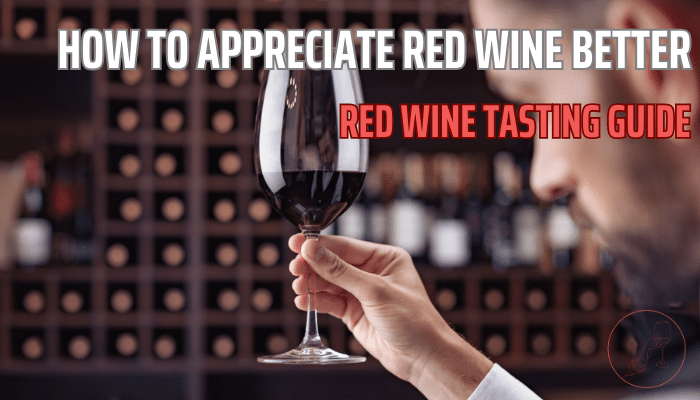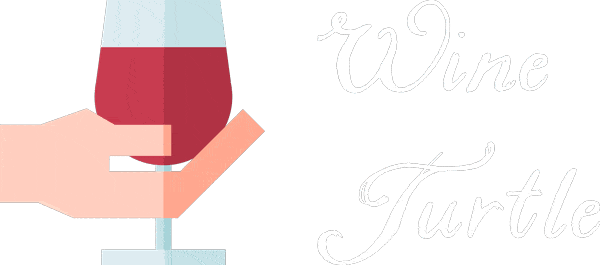How to Appreciate Red Wine Better [Red Wine Tasting Guide]

Wine tasting can be a bit intimidating, but if you want to not only learn more about wine but also be able to track down wines that you like, it's a good idea to get some tasting basics under your belt.
We'll start today with tasting reds - the method you'll follow; what you're looking, sniffing, and tasting for; common descriptors; tips and tricks; and also some suggestions for those of you thinking about taking your tasting ability to the next level.
The Steps of Tasting Wine
When tasting red wine, you will go through a series of steps in order to take in a variety of factors: color, aroma, mouth feel, acidity, tannins, flavors, finish.
We'll go through the steps and some basics now, but be sure to keep reading for information on each of these different factors. We'll have you tasting like a pro in no time!
Step 1 - Tip for Tint
The first part of your red wine tasting experience doesn't have to do with taste, it has to do with color.
Drinking wine is a sensory experience - we'll talk about everything except the sounds associated with wine (but aren't they musical?) - and it starts with, "What does the wine look like?"
What Does Red Wine Look Like?
Can you see through the wine, like a glass of cranberry juice? Can you not really see through it but light gets through? Or is it so dark you can't see much at all?
These are ways to describe wine and just like in science class you can use the same descriptors: transparent, translucent, and opaque.
When you tip or tilt your glass what happens? How does the wine change depending on its depth? Is it a different level of transparency or does the color even change?
Take time to get to know how wine looks and appreciate it. Describe the colors and enjoy them before moving on.
The 2 Places to Look at Red Wine
The Center
You'll first notice the center of your glass, pretty much everything other than the rim.
This is the primary color of the wine.
The Rim
Look around the rim for other colors - do you notice that the color seems to change? What do you see? Is the wine at the rim darker? Lighter?
Is it very different from the rest of the wine? Or barely visible?
Common Visual Descriptors
- Brown
- Purple
- Mahogany
- Ruby
- Copper
- Deep Red
- Brick Red
- Magenta
- Orange
Color Related Tips
- Color can tell you about the body of the wine: lighter colors mean a lighter bodied wine.
- A browner wine can be an indication that the wine is very old.
- Noticing a blue tint to your red? This is a sign that the wine is low in acidity.
- Another way to tell the age of a wine? The more difference between the primary color of the wine and the rim color the older the wine!
Step 2 - Take a Sniff, Give it a Swirl, Sniff it Again
After describing the color you'll move onto the aromas of the wine, often referred to as the bouquet.
By taking an initial sniff of the wine before aerating it, you'll get an idea of just how much it changes, or "opens up".
It's amazing how a few swirls can really change the scent. You can swirl wine by leaving on the table and placing your hand over the base and swirling it.
You can also hold the wine above the table and swirl when grasping the base or stem. Do whatever gets the wine moving the most smoothly and never sloshing outside of the glass.
After giving it some good swirls, stick your nose in the glass and take a big sniff for a few seconds.
What Does Red Wine Smell Like?
Fruit! The nose of a red wine is most often where you will smell fruit.
You may smell other things and you should definitely describe those, but by focusing on fruit in the beginning you will learn more about what to look for.
So, which fruits?
Red-toned ones... you're probably going to be able to recognize berries (raspberry, strawberry, blackberry, blueberry).
Sometimes you can smell other fruits: plum and cherry being very common.
There may be other scents beyond fruit but in the beginning, keep your focus there.
Of course, if you smell something else, feel free to mention it.
And say what it smells like:
Wood smoke? Leather? Vinyl?
These are often heard described when people are tasting reds. Smell portabello mushrooms? It's okay to say it!
Common Olfactory Descriptors
Fruit
- Raspberry
- Strawberry
- Blueberry
- Blackberry
- Cherry
- Plum
- Apple
Other
- Rubber
- Smoke
- Plastic
- Tar
- Pencil Lead
Aroma Related Tips
- Close your eyes. Focus your senses on what's important in the moment.
- When you're starting out, focus on the fruit - just the fruit! If something is overwhelming, go ahead and say it.
- Don't be shy. When tasting, especially with a wine expert, say what you smell. Winemakers, sommeliers, and other professionals are likely to tell you that they agree, or maybe give you a tasting term to think about. They might also tell you something you're missing. If you don't smell it, that's okay, too - but there is no better way to pick up some new skills than by discussing wine with experts.
Step 3 - Taste the Wine
To taste wine don't just take a sip and swallow. Wine is complex and in order to truly get a taste you have to make sure you experience both the taste and all of the tactile sensations.
You'll want to experience having the wine hit every part of your tongue to get the best experience of flavor.
The method to sip properly is:
- 1Take some wine into your mouth and allow to hit all the areas of the tongue and sides of the mouth.
- 2Take in a little air. You'll have to practice this skill but you want to do it through the wine that is in your mouth to aerate it there.
- 3Swish and chew. Yeah, sounds crazy but you'll thank us later - you want the wine to really spend time in your mouth.
- 4Swallow (or not, depending on the situation). Savor the moment and the few seconds after as many wines taste a little differently at the end and can often finish differently than they tasted on the initial sip. If you're tasting many different wines at a tasting you might not want to swallow as you might get drunk and cloud your judgement.
Related: Unimpressed by the taste of your wine? Don't miss our guide to salvaging disappointing wine!
What Does Wine Taste Like?
So many things! And often not the thing you'd think: grapes.
Funnily enough wine rarely tastes of grapes, at least not the kind we eat.
Winemaking takes a long time and over the course of their journey, the grapes transform into something else.
Fermentation and aging play a big role in this but other factors are at work too.
So what does wine really taste like?
Common Taste Descriptors
Fruit
There are two ways to think about fruit flavors in red wine (at least in the beginning): Red fruits/berries and black fruits/berries. See the tips in this section of a great way to explore identifying.
Spices and Herbs
Probably the most common spice tasted and thrown out at a tasting is black pepper, but eventually you might notice others.
White and black pepper are common, as are cinnamon, clove, anise (licorice), and others from your spice rack.
Sometimes it's hard to tell just what the spice is so "spicy" is in itself a descriptor.
As a general rule, red wine will have more tastes of spices and white wine of herbs.
Is that vanilla? A taste of vanilla is often an indicator that a wine has been oaked.
Vegetables
Often a sign of a flaw, some vegetable tastes are normal: green pepper, celery, mushroom. It often depends on the wine and the amount of the flavor so if you taste it - ask about it and learn!
Flowers
Floral tastes like roses can be dried or fresh and like with many other flavors you will sometimes only know that it tastes like flowers - so call it "floral".
But if it is distinct and you get lily of the valley, mums, roses, or honeysuckle, by all means please share!
Earth
You know the smell of rain? Or wet road? Or wood? Or mushrooms? These are earthy flavors.
They often have a distinct feel on your tongue and will immediately make your brain think "earthy".
Earthy is an acceptable descriptor but others include: forest floor, asphalt, tar.
Tasting Related Tips
- Better to describe a taste in an honest way than to try and sound like you know what you're talking about. More people will understand, "Like licking the inside of a tin can," than "like rain falling on seven dimes." Don't be fancy - say exactly what you taste if there is no name for it - you'd be amazed how many people will agree. And, the best part? Someone might tell you a name for it.
- When you start tasting and describing, it's okay to just use the broad terms: I get red fruit and spice.
- When trying to decipher fruits don't forget things like figs - which are black. Also, if it tastes more like candy it's likely a red fruit. Rounder, richer fruits = black. Lighter, sweeter fruits = red.
Where Should I Taste Wine?
Everywhere! At restaurants, in your home, alone and with friends - practice tasting whenever you can.
You can download and print wine tasting notes templates to help you on your journey.
It can be fun to taste with a friend and then compare notes. Sometimes you can even find tasting events live-tweeted on Twitter!
Engage with others when tasting, especially at a vineyard tasting room. Say what you taste, ask what they do.
Say, "I'm getting something that's a red fruit but I have no clue what it is - do you get that?" You might just learn that it's dragonfruit, something not everyone can recognize.
Related: Should you chill red wine? Find out more in our guide to serving temperature.
How Can I Take My Tasting to the Next Level?
The key is to keep practicing and expanding your wine vocabulary. By tasting different wines you will become familiar with a wide range of notes. You'll then be able to pinpoint them almost automatically.
Try new wines and be critical of them. Take notes and then compare them with notes of your friends or with reviews online. Go back and try the wine and see if you can uncover any notes that you missed.
Comparative wine tastings are great for expanding your tasting skills as there are usually similarities tying the wines together.
You can get some great tips for improving your tasting skills here.
Other Resources
Many wine shops, tasting rooms, and other wine businesses will offer tastings, classes, workshops and pairing dinners.
Wine festivals are also a great resource for learning more about tasting. Check out what's going on in your local community to see if there are available wine courses for you.
Now you know the steps to taste wine, some flavors to expect, and some descriptors.
So open a bottle of red, go through the steps, and tell us: how does red wine taste to you? We look forward to hearing from you in the comments!
